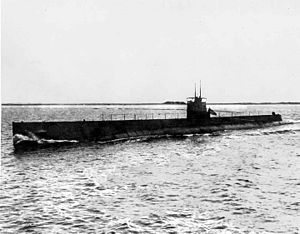AA-1-class submarine

USS AA-1 (SS-52)
|
|
| Class overview | |
|---|---|
| Name: | AA-1 class |
| Builders: |
|
| Operators: |
|
| Preceded by: | USS M-1 |
| Succeeded by: | N class |
| Built: | 1916–1922 |
| In service: | 1920–1927 |
| Completed: | 3 |
| Retired: | 3 |
| General characteristics | |
| Type: | Submarine |
| Displacement: |
|
| Length: | 268 ft 9 in (81.92 m) overall |
| Beam: | 22 ft 10 in (6.96 m) |
| Draft: | 14 ft 2 in (4.32 m) |
| Propulsion: |
|
| Speed: |
|
| Range: |
|
| Test depth: | 150 ft (46 m) |
| Complement: | 38 |
| Armament: |
|
The AA-1 class was a class of three experimental submarines of the United States Navy, built toward the end of World War I, between 1916 and 1919, intended to produce a high-speed fleet submarine. The design was not a success and none of the submarines saw active service. However, the lessons learned were applied to the design of the later V-boats. The class was later renamed as the T class.
In the early 1910s, only a dozen years after Holland inaugurated the Navy's undersea force, naval strategists had already begun to wish for submarines that could operate as long range reconnaissance vessels, in closer collaboration with the surface fleet than the Navy's existing classes, which had been designed primarily for coastal defense. These notional "fleet" submarines would necessarily be larger and better armed, but primarily, they would need a surface speed of some 21 knots (39 km/h; 24 mph) to be able to maneuver with the 21-knot battleships the battle fleet was built around. This was the designed speed of the Delaware class and later battleships, including the Standard-type battleships that were under construction and proposed in 1913.
In the summer of 1913, Electric Boat's chief naval architect, former naval constructor Lawrence Y. Spear, proposed two preliminary fleet-boat designs for consideration in the Navy's 1914 program. In the ensuing authorization of eight submarines, Congress specified that one should "be of a seagoing type to have a surface speed of not less than twenty knots." This first fleet boat, laid down in June 1916, was named Schley after Spanish–American War hero Winfield Scott Schley. With a displacement of 1,106 tons surfaced, 1,487 tons submerged, on a length of 270 feet (82 m), Schley (later AA-1, and finally T-1) was twice as large as any previous U.S. submarine. One drawback of the large size was that the design depth was reduced from 200 ft (61 m) to 150 ft (46 m). To achieve the required surface speed, two tandem 1,000 horsepower (750 kW) diesel engines on each shaft drove twin screws, and a separate diesel generator was provided for charging batteries. Although Schley and two sister boats authorized in 1915—AA-2 (later T-2), and AA-3 (later T-3)—all made their design speed of 20 knots (37 km/h; 23 mph), insoluble torsional vibration problems with their tandem engines made them very troublesome ships. As the engines were clutched together, it was impossible to perfectly synchronize their operation.
...
Wikipedia
